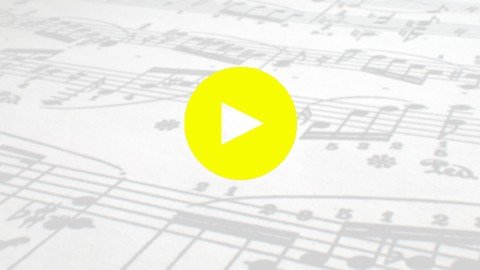
Free download скачать Udemy - Trinity Grade 3 Music Theory
Published 10/2024
MP4 | Video: h264, 1920x1080 | Audio: AAC, 44.1 KHz
Language: English | Size: 256.73 MB | Duration: 1h 29m
A complete course covering the Trinity Grade 3 Music Theory syllabus.
What you'll learn
Pass Trinity Grade 3 Music Theory with Distinction!
Build on your knowledge of how music works, and how to pass the Trinity exam
Further your skills in composition and harmony
Practise your skills with the included PDF, exercises and tests!
Requirements
You should already have covered the topics in Trinity Grades 1 & 2 Music Theory
You don't need any extra equipment or software to take this course - all materials are provided.
You need to be motivated to learn how music works
Description
Grade 3 Music Theory TrinityThis Grade 3 Music Theory video courses covers the Trinity syllabus in full.RhythmCompound time (time signatures of 6/8, 9/8 and 12/8 )Grouping semiquavers and semiquaver rests in simple and compound time (16th notes and rests)Dotted quavers and dotted quaver rests in simple and compound time (dotted 8th notes)Rules for grouping note and rest values within 6/8, 9/8 and 12/8 time signaturesQuaver triplets (8th note triplets)AnacrusisTies using new note valuesPitchNaming and using notes in treble or bass clefs (to three ledger lines above or below the stave)Bb and D major keys (for all major keys for the grade: scales, key signatures, one-octave arpeggios, broken chords and tonic triads (root or first inversion)G and B minor keys (for all minor keys for the grade: scales - natural (Aeolian mode) and harmonic and melodic, key signatures, one-octave arpeggios, broken chords and tonic triads (root or first inversion)Second inversions of major and minor tonic triads of keys covered so farIdentifying the key of a piece in Bb or D major and G or B minor5th degree of the major/minor scale being known as the dominant or soh (major keys only)Dominant triads for all keys covered so farMajor/minor dominant triad labelled:- as a chord symbol above the music (e.g. G in the key of C major or Em (E where the 7thdegree is raised) in the key of A minor)- as a Roman numeral below the music (e.g. V in the key of C major or v (V where the 7th degreeis raised) in the key of A minor)7th degree of the major/minor scale being known as the leading noteUnderstanding the term 'chord progression'Recognising a perfect cadence in the home key (major or minor)Intervals (major/minor 6th, major/minor 7th above any tonic for the grade)Writing tonic chords in root position in any key for the grade as well-balanced 4-part chords for SATBReal and tonal sequencesSimilar and contrary motionTransposing a tune up or down an octave from treble clef to bass clef and vice versaRanges of violin, flute, cello, bassoon, as defined in the workbookKnowing that violin and cello are string instruments, flute and bassoon are woodwind instrumentsMusical terms and symbols
Overview
Section 1: Introduction
Lecture 1 Introduction to Grade 3 Trinity Music Theory
Section 2: Rhythm
Lecture 2 Dotted Quavers (Dotted 8th Notes)
Lecture 3 Simple Time Signatures
Lecture 4 Compound Time Signatures: 6/8
Lecture 5 Compound Time Signatures: 9/8 and 12/8
Lecture 6 Compound Time Summary
Lecture 7 Beaming
Lecture 8 Rests
Lecture 9 Quaver (8th Note) Triplets
Lecture 10 The Anacrusis
Section 3: Scales and Key
Lecture 11 The Dominant and Leading Notes
Lecture 12 Major Scales: D major
Lecture 13 Major Scales: Bb major
Lecture 14 Melodic Minor Scales
Lecture 15 Minor Scales: B minor
Lecture 16 Minor Scales: G minor
Lecture 17 Key Signatures and the Circle of 5ths
Lecture 18 Working Out the Key
Lecture 19 Grade 3 Scales Reference Sheet
Section 4: Intervals and Transposition
Lecture 20 Intervals Review
Lecture 21 Major and Minor 6ths and 7ths
Lecture 22 Intervals from the Tonic
Lecture 23 Intervals - Some Questions
Lecture 24 Transposition at the Octave and between Clefs
Section 5: Harmony
Lecture 25 Tonic Triads Review
Lecture 26 Second Inversion Triads
Lecture 27 The Dominant Triad
Lecture 28 SATB | 4-Part Chords
Lecture 29 Introduction to Chord Progressions
Lecture 30 The Perfect Cadence
Section 6: Orchestration
Lecture 31 String Instruments
Lecture 32 Woodwind Instruments
Section 7: Composition
Lecture 33 Sequences
Lecture 34 Similar and Contrary Motion, and Consecutives
Lecture 35 Composition
Lecture 36 Writing a Bass Line to a Tune
Lecture 37 Writing a Tune to a Bass Line
Section 8: Terms and Symbols
Lecture 38 Terms and Symbols
Section 9: Grade 3 Practice Test
Lecture 39 Trinity Grade 3 Practice Test
This course is for candidates preparing for Trinity Grade 3 Music Theory
Screenshot
Homepage
https://www.udemy.com/course/trinity-grade-3-music-theory/
Buy Premium From My Links To Get Resumable Support,Max Speed & Support Me
Rapidgator
vwhbt.Trinity.Grade.3.Music.Theory.rar.html
Fikper
vwhbt.Trinity.Grade.3.Music.Theory.rar.html
No Password - Links are Interchangeable

